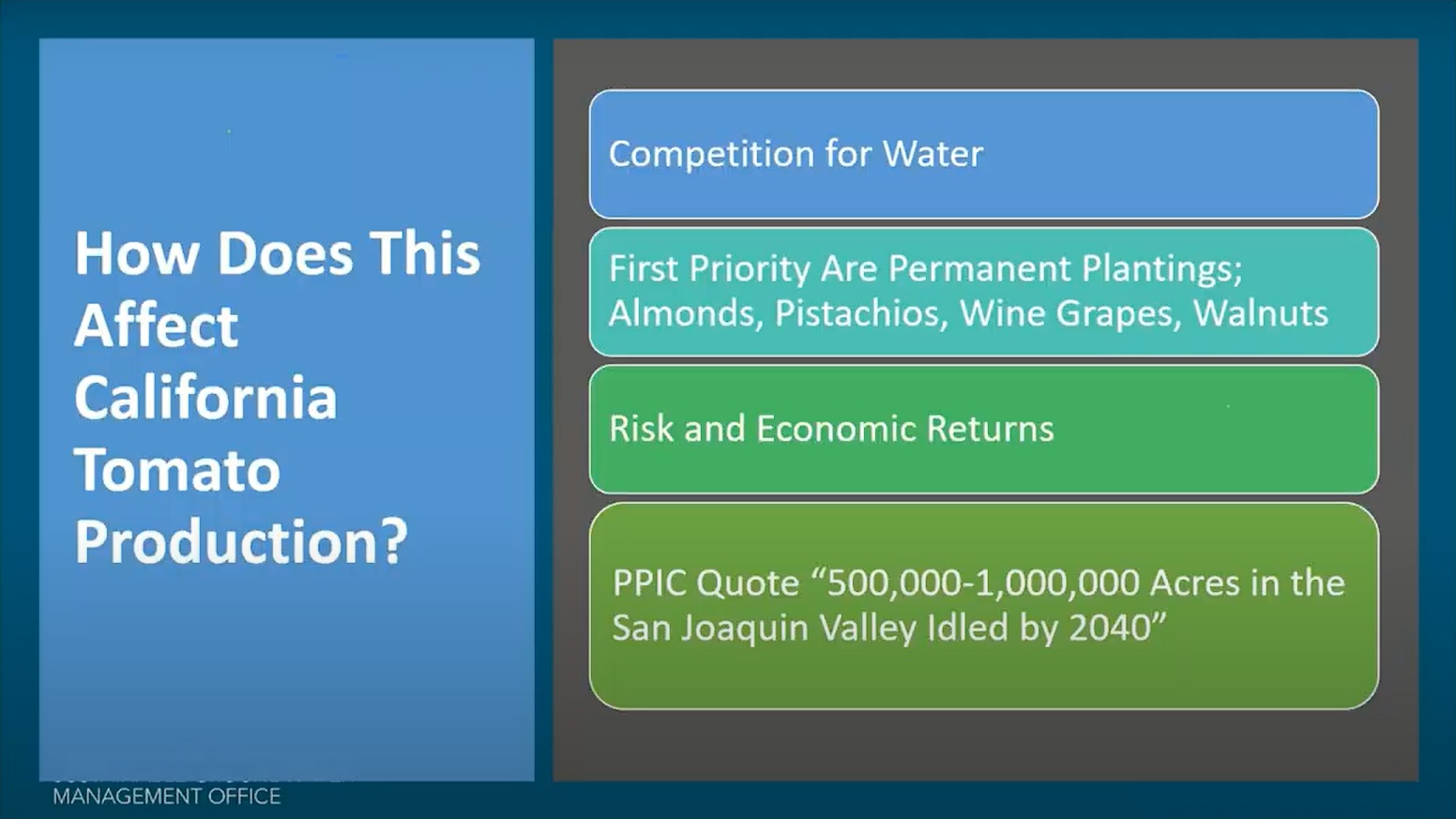How does it affect California tomato production?
We are seeing growers being squeezed on all sides. Where a grower could fall back on groundwater, those options are much less likely now. There is additional competition among crops for water. A grower is going to protect his investment in permanent planting – trees and vines, if they are productive and financially beneficial. Growers will look to field crops that require less capital to grow and have equivalent returns and use less water and present lower risks. The Public Policy Institute of California (PPIC), a very well-known institution in the State, has said that the San Joaquin Valley would have to fallow 500,000 to 1 million acres of farmland by 2040 to get the groundwater to become sustainable. It would essentially demand reduction. The State of California has already allocated 50 million USD for repurposing fallow land and there will be more to come, more additional dollars.
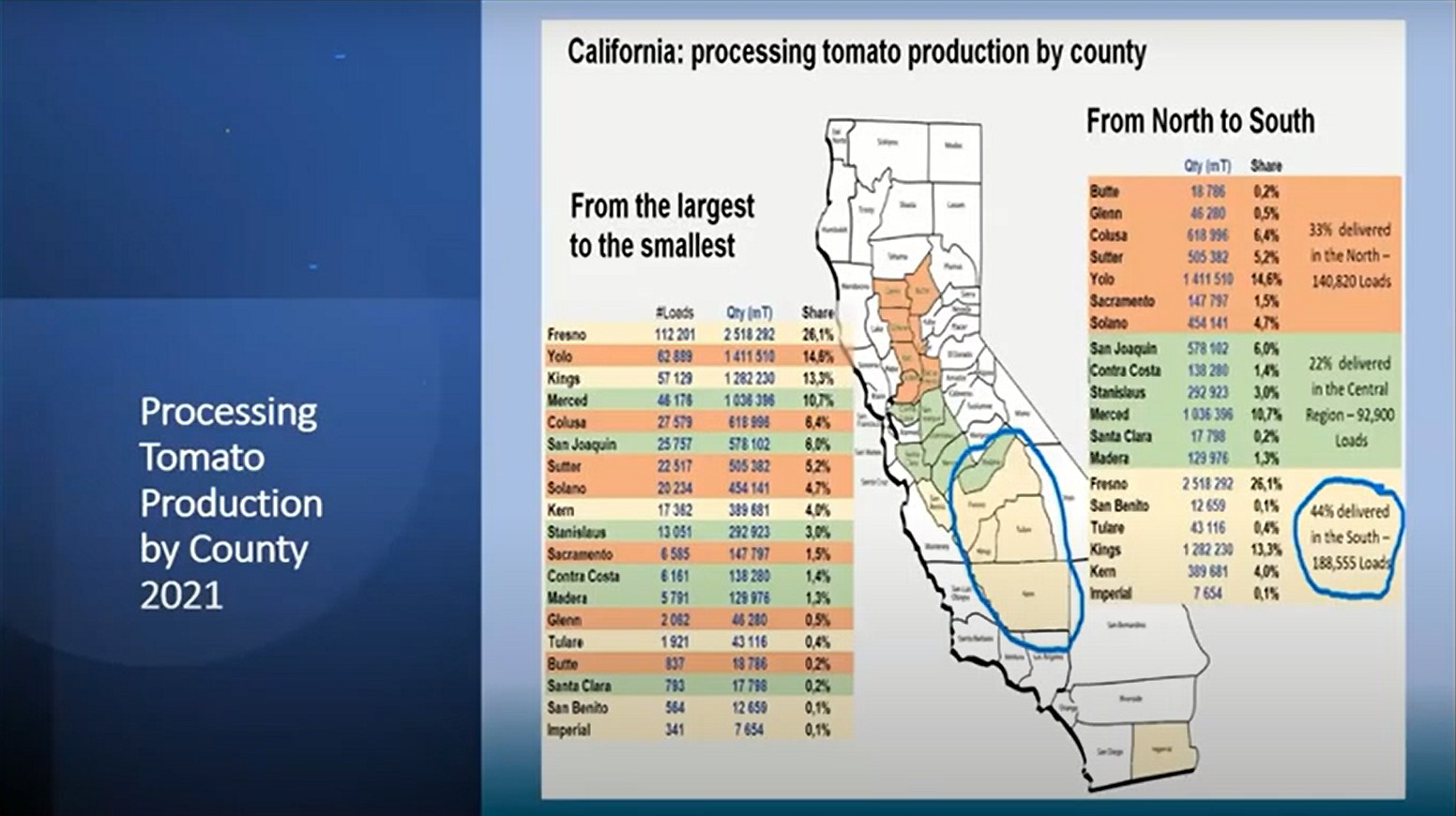 (Source: Tomato News)
(Source: Tomato News)If you look at the map, the area circled produces about 66% of California’s tomato crops – really the San Joaquin Valley. And this year, with the temperature spikes, we have reduced yields in much of this area.
As for the Westlands Water District, located in western Fresno County, it contains about 600,000 acres in production of various crops. It is really a good indicator of what is happening throughout the State with surface water allocations and groundwater pumping.
There are 600,000 acres in Westlands water district. The area has relied on Central Valley Project water, and when they had a 100% allocation, that would give them 2.4 acre-feet of water per acre. During the dry years, Westlands’ water just relied on groundwater, in many cases from wells anywhere from 600 to 2,200 feet deep. Westlands Water District is in a critically overdrafted basin, and it is now beginning to implement groundwater pumping restrictions to achieve groundwater sustainability. In the past, there were no restrictions on pumping groundwater, so groundwater pumping restrictions will begin to cut back on what a grower can pump in this area. Restrictions on pumping have been proposed to only allow a maximum of seven inches of water per acre (69 mm/ha), and in cases anywhere from three to four inches of water per acre per year. As you know, tomatoes typically take around 27 inches of water per acre (109 mm/ha).
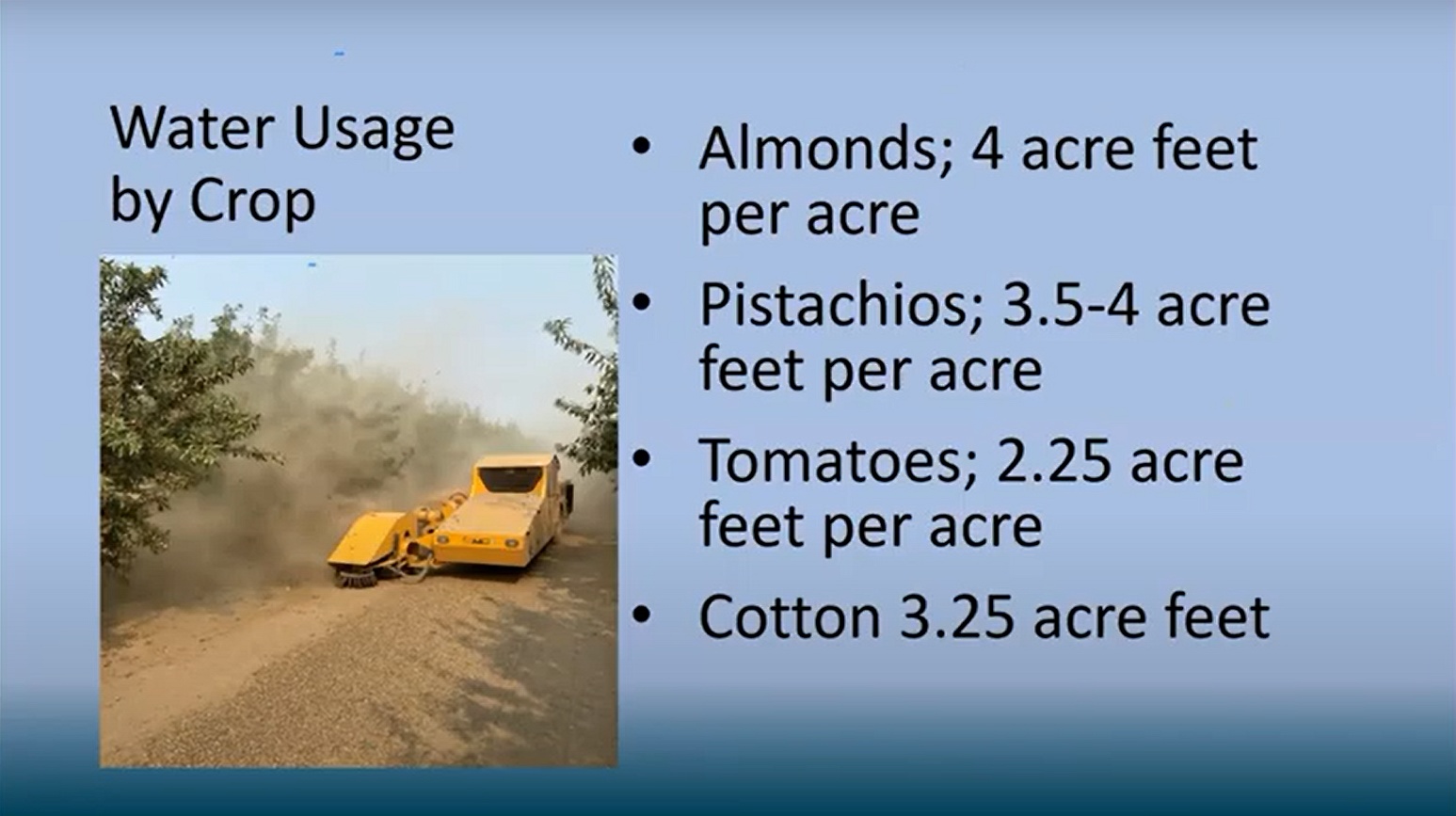
If we look at some of the competing crops, you can see the differences: almonds need approximately 4 acre-feet (per acre), pistachio 3.5 acre-feet, tomato 2.25 acre-feet and cotton around 3.25.
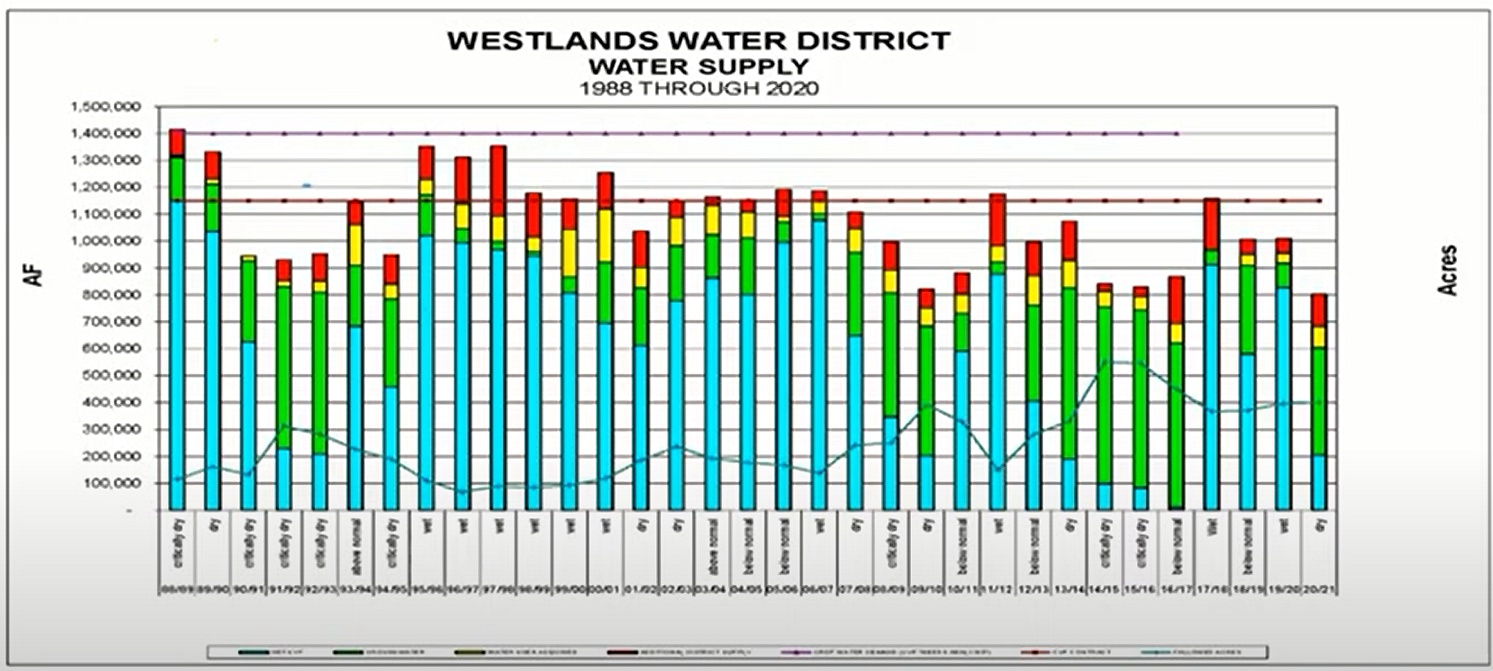
Looking at this slide, the two main things I want you to see are the blue color which is delivered CVP water and the green which indicates groundwater being pumped. If you look at some of the later years, the majority of the color you see is green, which means that during the drought, growers relied on groundwater pumping to sustain their crops. You also see a graft line that runs through the bar chart, indicating the amount of ground that has been fallowed in each year, so the grower can keep his other crops alive.
In dry years, we have seen water trade for as high as a little over 2,200 USD per acre-foot of water.
We know that there have been a lot of changes in Westlands Water District. We are going to look at the cropping patterns from 2000 to 2020, a 20-year period. We know that almonds are now the most planted crop in California, with 1.6 million acres (607,000 ha) of trees planted. So as we look at the major changes we have seen in Westlands – really the same has happened throughout California – we see that since 2000, almonds have increased by approximately 65,000 acres, a 291% increase. Pistachios in 2000 covered around 5,000 acres, and they are now at 53,000 acres – over 1000% increase since 2000. With processing tomatoes, we have seen a decline of 31,000 acres, a 49% decrease in acres. The cotton acreage has decreased by 93% within Westlands. We have also seen increases in yields for processed tomatoes, but from 38 tons statewide in 2000 to approximately 48 tons in 2020, an increase of 26% due to better genetics and the advent of subsurface drip irrigation around 2010. But that still looks to me to be a reduction in tomato production of half a million tons.
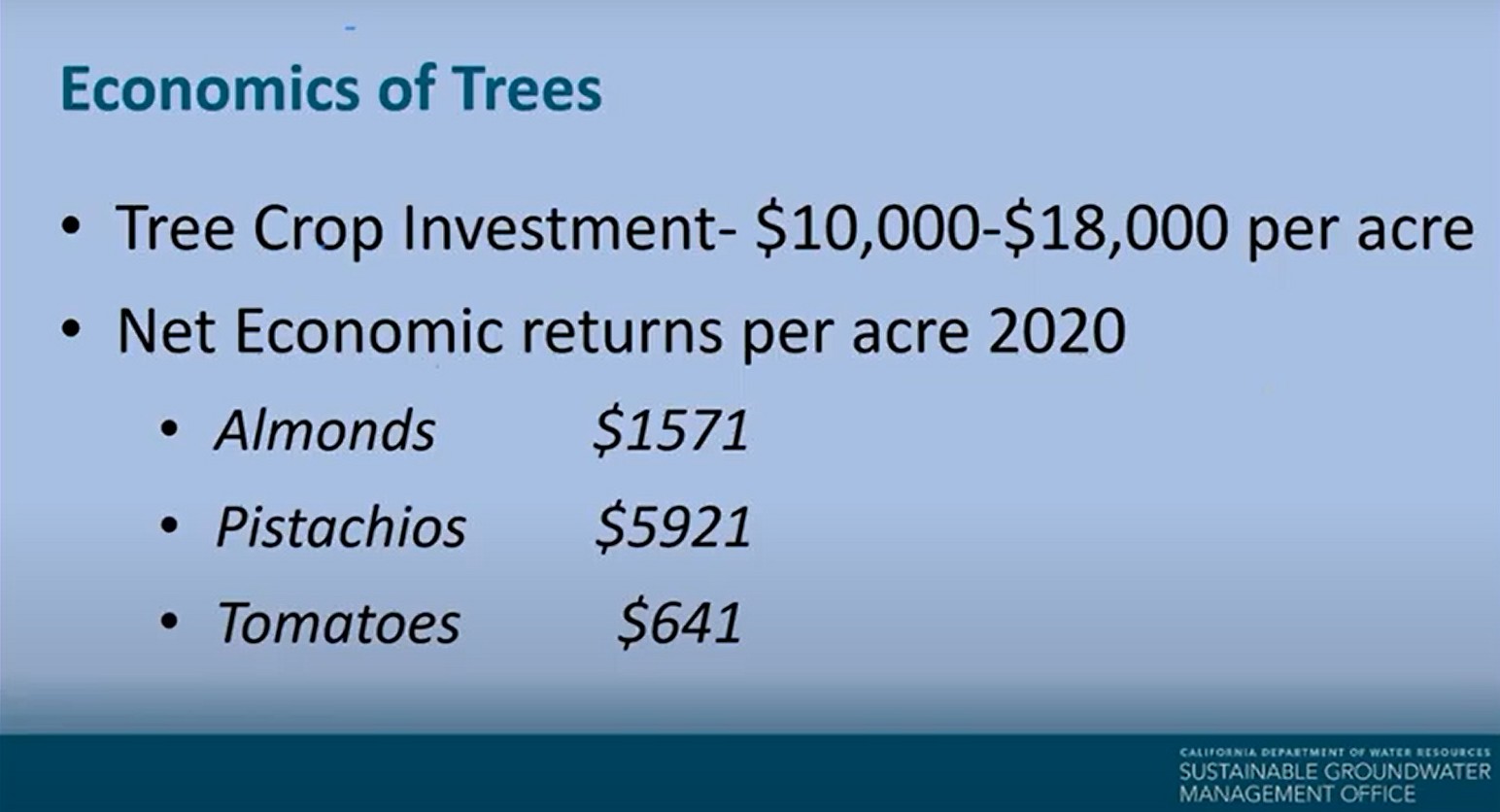
When we look at the investment growers have made in permanent planting, we are looking at anywhere from 10,000 to 18,000 USD per acre for pistachios or almond production. These are real numbers that I took from our own farming operations from 2020. This is net income, and you can see these were not exorbitant prices for any of these crops here by any means. It was an “on year” for pistachios and we know that it was followed by an “off year” – they are cyclical, but it was an “on year” even if you take half this number, you can see what kind of returns we are getting.
So growers have to choose what crop they are going to plant and what kind of return they are looking at long-term. Economic returns are definitely better for tree crops when compared to processing tomatoes and when we speak about risk, almonds and pistachios are less at risk than tomatoes from frost, hail, rains at the wrong time, etc. I am not saying tree crops are immune from that, but tomatoes have definitely been affected in recent years.
We have come a long way. We know that change is constant in everything we do, and we know farming is not different. There will be those that change, and there is going to be those that do not. There is going to be those that lead and there will be those that will not. If we keep our industry strong, we need to make the necessary changes using the foresight of our leaders in the industry.
California tomato growers have been the most innovative and progressive, and able to change rapidly when necessary. In California, we have developed a strong and resilient industry that produces 95% of the US production and a third of the world’s supply of processing tomatoes, in the most regulated environment in the world. We produce healthy sustainable food that is welcomed into homes and restaurants around the world.
So how do we survive? The trees in California have a long lifespan – almonds 25 years, pistachios possibly 100 years or more, provided we have the water to sustain them. We need to understand that in California, and I would assume in many other parts in the world, competition for water will only get more intense as the population increases and our climate changes. To keep the tomato industry viable and strong, we need tomatoes to be competitive. If you look back to the cotton industry in California, in the 60s and 70s, there were over 1.6 million acres in the State – the #1 crop. Now they are fortunate if they get 140,000 acres. Infrastructure is gone, cotton gins have been sold to overseas buyers, so that even now, with the price spikes we are seeing, there is very little increase in planted areas.
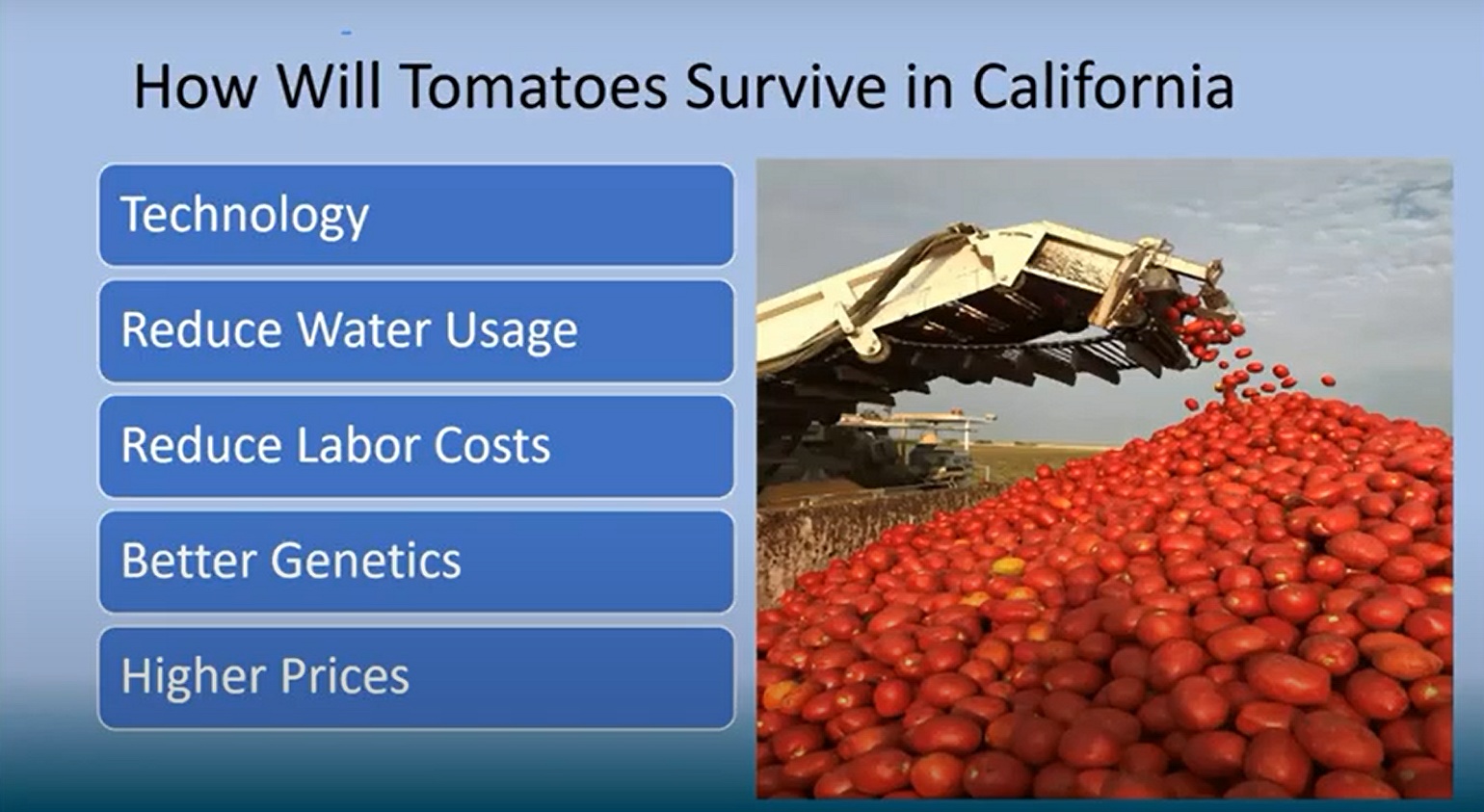
How will tomatoes survive in California?
I believe that the processors that don’t understand the new reality will have a very difficult time in the future in California. The risk reward for tomatoes has been a hard-sell lately, with expenses growing for the crop and really skyrocketing. Now with climate changes, we are seeing hotter summers and lower yields. In 2021, California experienced a yield reduction in the south of the State of 25 to 40% due to heat alone. We know that the price increase was big this year, but growers are still having a difficult time and this increase may not be enough. We need to be creative, we need to rely on technology, we need to reduce labor, reduce water usage, and we need more efficient genetics. As you just heard, we need a tomato plant that will grow without water, the way things are going now. But we have seen from the charts earlier that even in a wet scenario, water is not getting to the growers. There is an increased demand for municipal and industrial use, at present, and environmental water is increasingly using more of what agriculture traditionally used. Water for salmon, to keep rivers cool during the summer and increase flows in the rivers for fish populations, as well as water demands from our Delta water users – all of these things have put pressures on our system, pressure that is redistributing water from agriculture to other uses within the State.
Labor in California has been difficult to obtain when needed. Current H2A programs to bring labor into the country have been expensive and cumbersome. Our farm ordered a laser-weeder for burning weeds just recently: it moves across the field of newly emerged carrots, identifying weeds from carrots and only taking off the weeds. We know this is a big step forward toward our future. The cost for this machine is around 1.2 million USD, which sounds extremely high – and no doubt it is. However if you spread it over 10 years, it may work for us. The first model is extremely slow. We know speeds will increase; and prices will come down as production increases. Automation of infield drip irrigation is moving forward at a rapid pace. We need new technology to simplify irrigation for field crops that are only in the ground for 140 days or less. Fairly easy to automate permanent planting such as almonds, pistachio trees or vine crops are fixed in one place for 20 years. We need flexibility and rapid mobile technology for tomatoes, to reduce labor and apply precisely the amount of water needed for tomatoes. We need better genetics, our yields have been on an incline for many years, they have now plateaued or are decreasing. We need disease resistances; we need plants that have heat tolerance as temperatures increase. We need to have the ability for tomato plants to repel insects and diseases and we need to convince the general public that new scientific breeding techniques are safe, effective and sustainable, while improving our quality and yields.
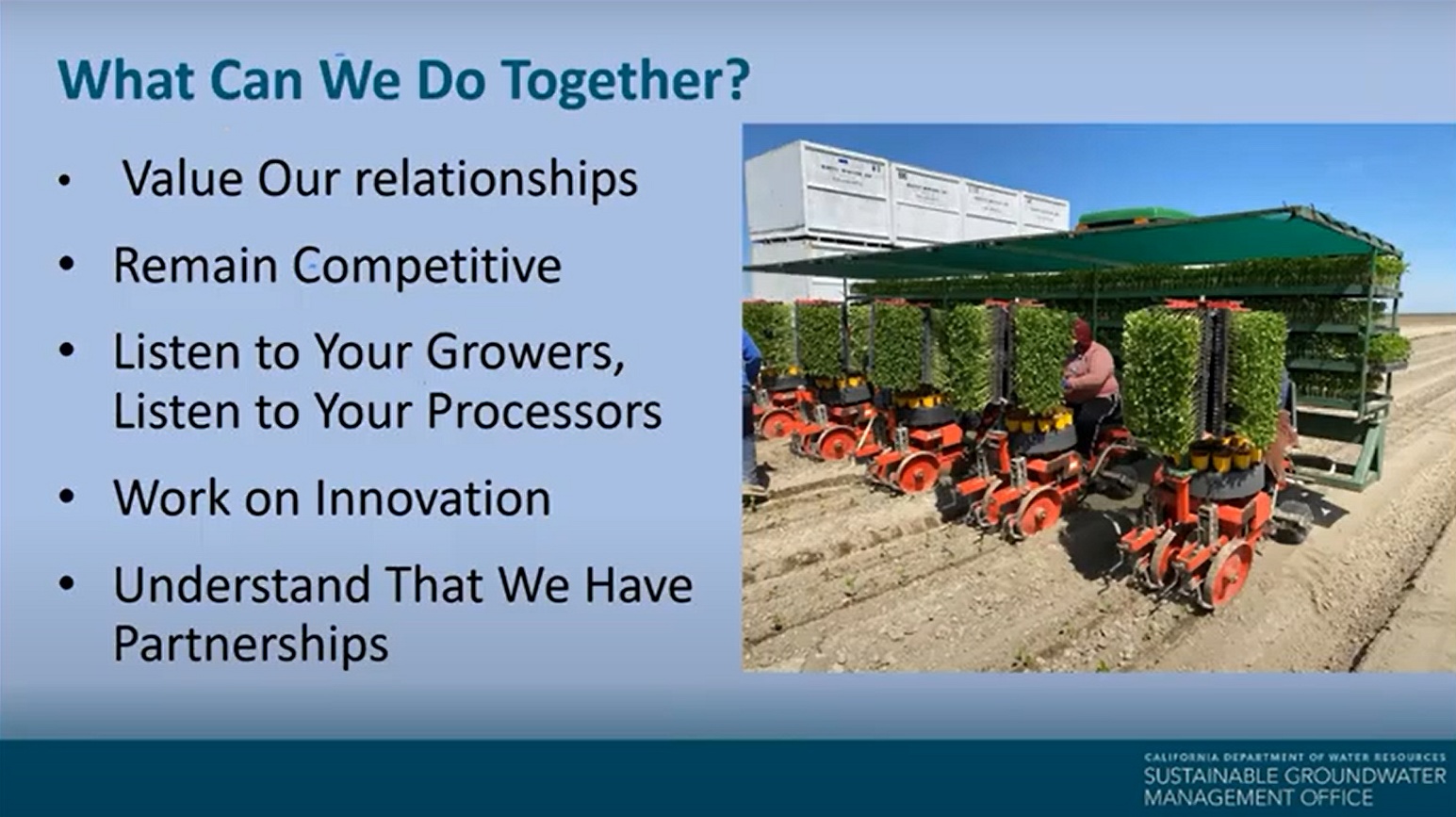
To be successful, growers and processors need to begin to work together. We both have issues; growers and processors have large financial investments in the tomato industry in California. Growers want successful, reliable processors and processors want successful, reliable growers. We both want consistency, reliability and profitability, and working together, I believe we can achieve a strong, resilient industry that our ultimate buyers can count on.
In 2013, our farm grew its last cotton crop. We sold the harvesters and other equipment. In 2022, our farm cut back on pepper acreage from over 700 acres to 75 acres. Why? The pricing didn’t keep pace with production costs. Unfortunately, tomato pricing has been under pressure for many years. The increase we saw this year of approximately 25% has been long overdue. We saw equivalent increases in our onions and garlic from our buyers. We anticipated a decent water supply, a decent water year in December, which was extremely wet. However, January to March turned out to be record-setting for no precipitation or rainfall.
Today (March 31, 2022), the federal water allocation stands at zero, the State Project just changed from 15% to 5% allocation for 2022 and I wouldn’t be surprised if it ends up at zero, the way things are going, unluckily. Restrictions and groundwater pumping continue to get worse – I had assumed when we started talking about groundwater controls that corn for silage for our dairies would disappear because it was a very water-intensive crop and a very low price commodity for growers, but what happened? The dairymen decided to move the price up, realized they had to have a crop and now we are seeing substantial increases in pricing where I can grow a crop and make it profitable – probably a profit better than tomatoes with much less risk and much less work.
We are looking at some tough situations in California. If growers have to fallow land to survive, we still have mortgage payments, we have taxes, equipment payments on the entire farm – not just the land that gets planted that year. We need profitable crops to remain in farming and we always know the risk is part of a farmers’ life and that all growers can’t be profitable or remain in business. We also see the same for tomato processors; those that work with growers instead of against them will succeed. We will have occasional years of flooding and plenty of available water for tomatoes and other crops, but we are living with change – change that will affect California agriculture’s future. Do we downsize our industry and only produce for the domestic consumption and only export in good water years? Do we overproduce in wet years, hold back product for dry years? I don’t know if a processor can idle facilities during low production years, any more than a grower can survive idling half of his land and wait for wet years.
Now, out of the last ten years, we have had three flood years and seven dry years. Maybe this is our new normal. I really don’t have the answers, but I do know that some of us will survive and some won’t, in California.”
Some complementary data
Latest News: according to the latest weekly report from the US Drought Monitor, the two major reservoirs were at "critically low levels" as of May 7, 2022, at the point of the year when they should be at their highest.
At this date, Shasta Lake was only at 40% of its total capacity, the lowest it has ever been at the start of May since record-keeping began in 1977. Meanwhile, further south, Lake Oroville is at 55% of its capacity, which is 70% of where it should be around this time, on average.
According to markets.cbsnews, water-use is up in drought-ravaged California, where it jumped dramatically in March, State officials said recently. Californians averaged 77 gallons (291.48 liters) per person per day in March 2022, an 18.9% increase from March 2020. It is the most water Californians have used in March since the middle of the previous drought in 2015. Statewide, water consumption is up just 3.7% since July compared to 2020.
Demand for non-agriculture water is typically low in March, which comes near the end of the State’s rainy season. But California got just 1 inch (2.54 centimeters) of precipitation in March, while temperatures were 3 degrees warmer than usual, further increasing water demand.
State officials said 20% of the wells they monitor are reporting all-time low water levels, while nearly half of them have less than 10% of their historic averages.
Video of the Conference is available at:
https://www.youtube.com/watch?v=xwNRr50G_nc
Sources: World Processing Tomato Congress (whova.com), marketplace.org


